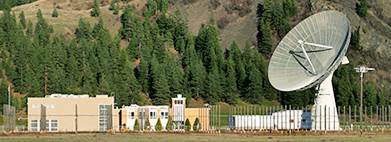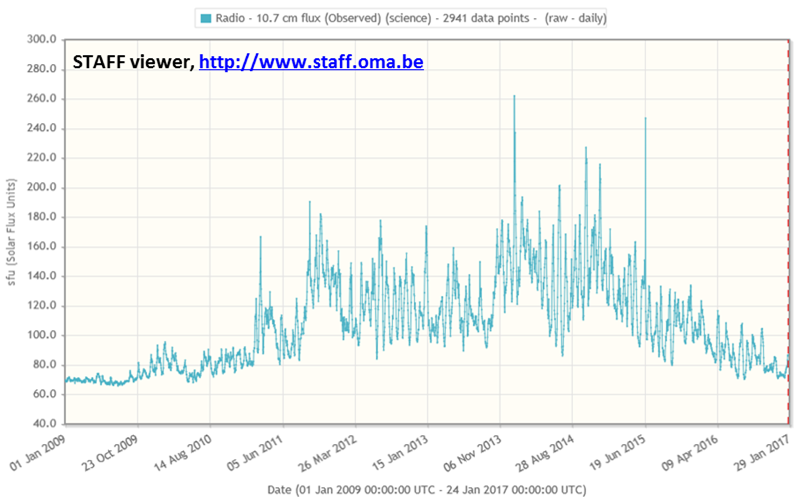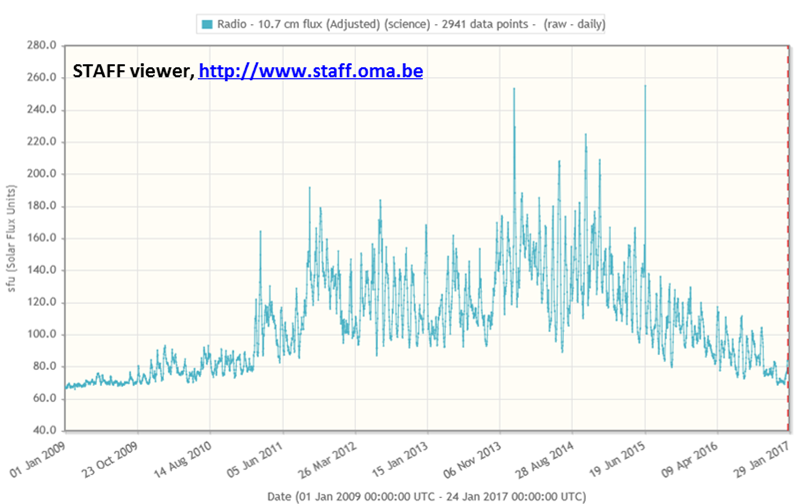Every day, the Dominion Radio Astrophysical Observatory (DRAO) in Penticton, BC, Canada, measures and publishes the values of the 10.7 cm solar radio flux on their website. The wavelengths around 10.7 cm (frequencies around 2800 MHz) are ideal for monitoring the solar activity, as they are very sensitive to conditions in the upper chromosphere and at the base of the corona. As a result, this radio flux is widely used in solar research and space weather applications. It is measured three times daily: around 17UT (18UT in winter), 20UT (local noon at Penticton), and 23UT (22UT in winter). The 20UT value is usually taken as the radio flux for that particular day.

The radio flux actually consists of three components. One is related to radio bursts associated with solar eruptions, which makes the flux values suddenly change over minutes to hours. Another is a more gradual variation primarily related to the active regions and the overall solar cycle evolution. This is the so-called slowly varying or "S" component, and varies over several days to years. The final contribution comes from the quiet sun background emission. It makes that, even when the sunspot number is zero for several days as during a solar cycle minimum, the 10.7 cm radio flux is not zero but at a (flat) level around 65 sfu (solar flux units, with 1 sfu = 10-22 W m-2 Hz-1).

As a result of the low solar activity during the last few months, very low radio fluxes have been recorded. For example, on 9 January 2017, the observed radio flux was only 71.2 sfu. On 28 July 2016, the lowest value since the most recent solar cycle maximum was observed (70.3 sfu). These are values not seen since the end of the previous solar cycle minimum period in 2010, as can be deduced from the graph above showing the daily observed radio fluxes. The two spikes that are prominently present in 2014 and 2015 correspond to strong, long duration flares just before local noon at Penticton (20UT), resp. on 4 January 2014 with an M4.0 flare peaking at 19:46UT, and on 22 June 2015 with a M6.5 flare peaking at 18:23UT.

However, radio fluxes have to be compared on equal footing. Indeed, as the orbit of the Earth around the Sun is not a circle but an ellipse, the Earth is sometimes closer to and sometimes further away from the Sun than average. During its point closest to the Sun ("perihelium") early in January, the Earth is about 3.3% or 5 million km closer to the Sun than during its "aphelium" in July when it is furthest from the Sun. For the same radio emission from the Sun, the Earth will clearly receive less radiation when it is further from the Sun, and more when it is closer to the Sun. Hence, the daily observed radio flux has to be corrected for this difference in distance. The new value is called the adjusted radio flux, i.e. adjusted to the same distance of 1 astronomical unit or the average Sun-Earth distance. The graph above was compiled from these adjusted values. It shows that the 12 December 2016 (68.6 sfu) and 9 January 2017 (68.9 sfu) were the lowest since the last solar cycle maximum. In fact, we have to go back all the way to 30 August 2009 to find an even lower value (68.5 sfu) than that of 12 December 2016. A sobering thought that the new solar cycle minimum is gradually approaching.
Credits - The above text was freely inspired on the information and data available at the DRAO website and on the paper "The 10.7 cm solar radio flux (F10.7)" by K. F. Tapping (2013). The charts were created using STAFF viewer.





